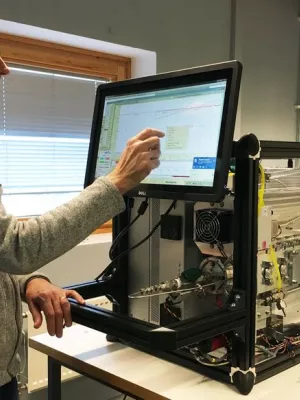
Erik Swietlicki
Professor

Development and characterization of the Portable Ice Nucleation Chamber 2 (PINCii)
Author
Summary, in English
The Portable Ice Nucleation Chamber 2 (PINCii) is a newly developed continuous flow diffusion chamber (CFDC) for measuring ice nucleating particles (INPs). PINCii is a vertically oriented parallel-plate CFDC that has been engineered to improve upon the limitations of previous generations of CFDCs. This work presents a detailed description of the PINCii instrument and the upgrades that make it unique compared with other operational CFDCs. The PINCii design offers several possibilities for improved INP measurements. Notably, a specific icing procedure results in low background particle counts, which demonstrates the potential for PINCii to measure INPs at low concentrations (<10L-1). High-spatial-resolution wall-temperature mapping enables the identification of temperature inhomogeneities on the chamber walls. This feature is used to introduce and discuss a new method for analyzing CFDC data based on the most extreme lamina conditions present within the chamber, which represent conditions most likely to trigger ice nucleation. A temperature gradient can be maintained throughout the evaporation section in addition to the main chamber, which enables PINCii to be used to study droplet activation processes or to extend ice crystal growth. A series of both liquid droplet activation and ice nucleation experiments were conducted at temperature and saturation conditions that span the spectrum of PINCii's operational conditions (-50≤temperature≤-15°C and 100 ≤ relative humidity with respect to ice≤160%) to demonstrate the instrument's capabilities. In addition, typical sources of uncertainty in CFDCs, including particle background, particle loss, and variations in aerosol lamina temperature and relative humidity, are quantified and discussed for PINCii.
Department/s
- Combustion Physics
- LTH Profile Area: Aerosols
- Nuclear physics
- MERGE: ModElling the Regional and Global Earth system
- LU Profile Area: Light and Materials
- LTH Profile Area: Nanoscience and Semiconductor Technology
- Metalund
- Consortium for Aerosol Science and Technology at Lund University (CAST)
- Centre for Environmental and Climate Science (CEC)
- NanoLund: Centre for Nanoscience
Publishing year
2023-08-23
Language
English
Pages
3881-3899
Publication/Series
Atmospheric Measurement Techniques
Volume
16
Issue
16
Document type
Journal article
Publisher
Copernicus GmbH
Topic
- Meteorology and Atmospheric Sciences
Status
Published
ISBN/ISSN/Other
- ISSN: 1867-1381